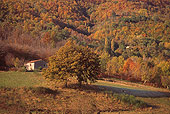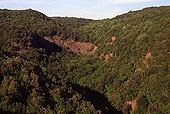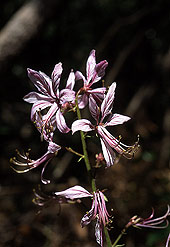  Nella parte alta della Valle, nel comune di Castelnuovo V.C., sono diffusi boschi di latifoglie decidue molto simili a quelli di areee appenniniche  Macchie e leccete nella Valle del Botro al Rio nella Riserva Naturale di Berignone  Il dittamo (Dictamnus albus), fiore molto raro i Toscana, nella Valle è conosciuto a Monterufoli  Il narciso (Narcissus poeticus) rappresenta uno dei fiori più importanti e più belli della Valle  Fior di bombo (Ophrys fuciflora) diffusa nelle aree aperte insieme a numerose altre orchidee |
 Risorse Ambientali Risorse Ambientali |  Flora e vegetazione Flora e vegetazione | FLORA AND VEGETATION
Val di Cecina boasts a plant bio-diversity which is among the richest one in Italy. Thanks to the climate which is not well defined and is between Mediterranean climate and that of continental Europe, and thanks to its particularly rough morphology, different types of vegetation are present, which are typical of Mediterranean coastal areas, with woods similar to those of central Europe. In the hillsides exposed south, Holm-oak woods can be found as well as the typical maquis formations, where it is possible to observe numerous Mediterranean species such as strawberry trees, guelder roses, heathers and phillyreas. In more shadowy and cool areas, instead of woods of evergreens, there are woods mainly characterised by deciduous broad-leaf trees (plants that lose their leaves in the fall) such as oak, downy oaks, durmast, and in more humid areas, white carpinus and fraxinus angustifolia. In the higher part of the valley, there are also chestnut woods, which sections that are still cultivated; the cultivation of chestnuts to produce flour saw in the Middle ages its utmost diffusion and still represents today a family based micro-economy.
All these woods, in addition to the extensive reforestations of pines carried out between 1930 and 1960, create a continuous forest cover that during the fall fills the landscapes with colours. Reaching the most hidden gorges along the torrents means to go through particular micro-climates where it is possible to find the relict species of the Tertiary period, such as yew trees, laurels, hollies, or the rare Silk vine. More at the bottom, the clear waters of torrents run along the typical riparian vegetation with willow trees, poplar trees, fraxinus and alders. In areas with rougher morphology, and with the presence of ophiolite rocks, instead of the woods we can find low maquis, garigues (low plant formations which do not cover the soil completely) and prairies, where the excursionist is immersed in Mediterranean scents and comes into contact with the most important flora species. In these environments, rare  endemic species can be found such as Alyssum bertolonii, Euphorbia nicaeensis ssp. prostata, Stachys recta var. serpentinii, Thymus striatus ssp. ophioliticus, Minuartia laricifolia var. ophiolitica, Armeria denticulata or beautiful flowers such as Iris lutescens, Iberis umbellata, Tulipa australis, Iris graminea, Narcissus poeticus and Campanula medium. There are also very numerous orchids, more than 30 species.
Men have always frequented the woods that up until the 60s were intensely cut for the production of carbon and fire wood and pasture in some cases; nowadays, the wood market is recovering while carbon is no longer produced. endemic species can be found such as Alyssum bertolonii, Euphorbia nicaeensis ssp. prostata, Stachys recta var. serpentinii, Thymus striatus ssp. ophioliticus, Minuartia laricifolia var. ophiolitica, Armeria denticulata or beautiful flowers such as Iris lutescens, Iberis umbellata, Tulipa australis, Iris graminea, Narcissus poeticus and Campanula medium. There are also very numerous orchids, more than 30 species.
Men have always frequented the woods that up until the 60s were intensely cut for the production of carbon and fire wood and pasture in some cases; nowadays, the wood market is recovering while carbon is no longer produced. |
|


 This text is also This text is also
available in English Language

 Flora e vegetazione Flora e vegetazione | |
|
|
|
|
|

|

